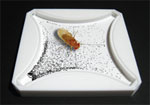Strong Odor Flips a Neural Switch Between Attraction and Aversion
MAY 4, 2009
By Susan Brown

Even the most alluring scent can turn repellant when the smell is too strong, but how that switch between attraction and aversion gets flipped in the brain was unknown.
Now UC San Diego graduate student Julia Semmelhack and her advisor, biology professor Jing Wang, have identified sites in the fruit fly brain that separately determine whether the insects will approach or avoid the odor of rotting fruit.
Although complex scents activate an array of distinct sites within the brain, a single cluster of interconnected cells can control a fly's response, they report in Nature this week.
Apple cider vinegar smells like a fly's favorite food, rotting fruit, and a whiff of the scent activates six separate clusters in the sensory area of the fly brain. By turning those clusters off one-by-one, using genetic techniques, they found two that are essential for the behavioral response to the smell.
"I saw a dramatic drop in attraction to the odor when I abolished either one," Semmelhack said.
Just three parts per million, a concentration equivalent to about a minute in eight months, is enough to send a fly toward the scent.
Increase the concentration, though, and the fly will stay away. The researchers found that a stronger dose of vinegar - 32 parts per million - activated an additional cluster of cells. When they silenced that seventh cluster the aversion to the stronger scent went away.
Their results demonstrate that these individual clusters of cells, rather than a pattern of activity across a wider region of the brain, process information about odor and determine a behavioral response.
The Whitehall Foundation and the National Institute of Deafness and Communication Disorders funded the research.
Comment: Jing Wang, jw800@ucsd.edu, 858-534-5597 or Julia Semmelhack, juliesemmelhack@gmail.com
Media Contacts: Susan Brown, 858-246-0161,sdbrown@ucsd.edu
